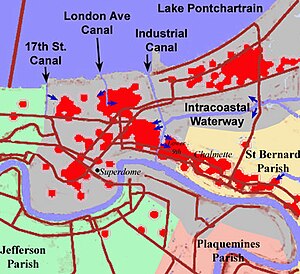Hurricane Katrina made landfall on August 29, 2005, implicated widespread damage and failure of 50 levees and flood wall in New Orleans, Louisiana. The storm produced by Hurricane Katrina, damaged the Hurricane Protection System (HPS). Levee failure occurred because of misinterpretation of geographical conditions and unforeseen failure mechanism. The levee and flood wall failure caused major amount of flooding in New Orleans. The extent of the destruction made it difficult to count for the victims, but the toll a year later was listed as 1,118 dead people and 135 missing. More than 400,000 citizens fled the city. Property damage reached tens of billions of dollars. United States Army Corps of Engineer (USACE) were responsible for designing and constructing levee system, but the maintenance of levee was scheduled to local levee board. Immediately after realizing that various components of the levee system had failed, the U.S. Army Corps of Engineers responded through high rate of emergency operations. The levee system was surveyed by air to determine the conditions of the construction. Many major investigations were conducted by civil engineers and experts from other departments and it was analyzed that the cause of flooding was inadequate design and construction by USACE.

In the year 1927, After the Great Mississippi Flood, Government passed the ‘Flood Control Act’ which authorized the U.S. Army Corps of Engineers to design and construct flood controlling structures, along with levees, on the Mississippi River to protect populated areas from floods. Combination of Wind and storm are the damaging agents of a hurricane, storm surge at the coast and the wind away from the coast. Hurricane Katrina, unfortunately, came ashore at high tide, and also brought heavy rainfall increasing the probability of flooding. There were many predictions of hurricane risk in New Orleans. Many local papers published a story focusing on the fact that the city’s levee was only designed for impact intensity for Category 2 hurricanes, but hurricane Katrina was Category 3. The following are the major sites, where, the breach took place:
1.17th Street Canal
2. London Avenue Canal- North and South
3. Lower Ninth Ward
4. St. Bernard Parish

Levees are the structures which do not have any concrete or steel parts. The extent of breaching and over topping scour was a function of soil type and compaction effort applied to the levee fill material, as well as the severity of the surge and wave action. Levees that had been constructed using hydraulic fill and had higher silt and sand content were severely damaged. On the other hand, rolled fill levees that were constructed of cohesive materials, for the most part, were able to survive over topping without breaching during this event. The mechanism of failure at the 17th Street Canal, London Avenue Canal, were improper design of the canal flood walls. The failure mechanism for Industrial Canal was over topping of levees and flood walls. Primary failure in eastern Orleans was due to contain of soil instead of thick clay. The failure of levee protecting St. Bernard Parish was due to negligent maintenance.

On April 5, 2006, months after investigators had demonstrated that levee failures were not due to natural forces beyond intended design strength, U.S. Army Corps of Engineers admits that they had a problem with the design and construction.

The devastation of Hurricane Katrina is having a significant impact on USACE. Successful performance of flood barriers reinforced the application of adequate design procedures. Unsuccessful performance has brought to light project deficiencies and has underscored USACE’s need to better understand project failure modes and the foundation conditions on which the projects are built.
The following are the points that are realized and changed after the incident;
1. Embrace safety and understanding the risk.
2. Quantify the risks.
3. Communicating the risk to the public.
4. Fix the Hurricane Protection System.
5. Have an improved engineering quality.
6. Upgrading engineering design process. 7. Place Safety first.
Reference
https://en.wikipedia.org/wiki/2005_levee_failures_in_Greater_New_Orleans

